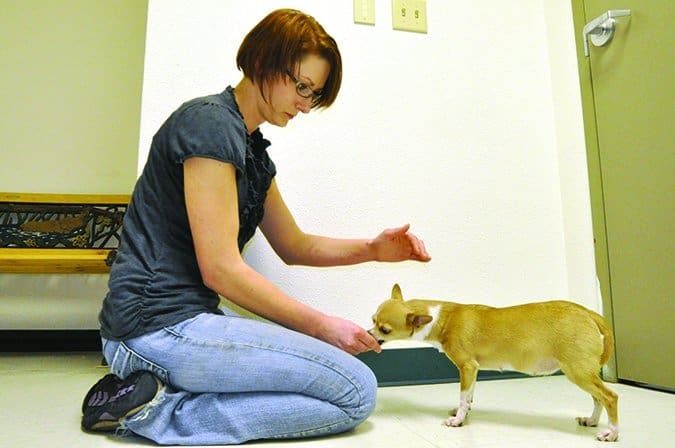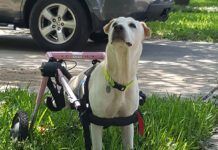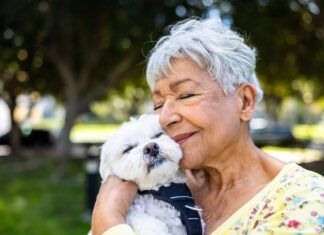Does your puppy or adult dog squirm when you check his ears? Squeal as you touch his toes? Or slink away when you bring out the brush? If so, you are not alone. A very few easygoing dogs seem to have been born enjoying all types of touch and handling. But most puppies and dogs need a little help when it comes to sensitive areas and intrusive touch. Is it really possible to help a dog learn to tolerate all types of handling? Absolutely! And, with a little special attention and training, your dog may even come to love the same types of touch that used to make him squirm, squeal, or slink away.

Handling Exercises: Start Them Young
Handling exercises are an important part of early socialization. One of the best ways to prevent problems with handling later in life is to make handling exercises a priority with your pup. Prior to 12 weeks of age, pairing handling and touch with pleasant experiences – say, a tasty treat – can help condition the pup to enjoy all types of touch.
For example, you may want to gently touch your puppy’s ear, and then give her a great treat. After she is happy and comfortable with you gently touching her ear, then you can lift the ear, and once again give the pup a treat. When she is comfortable with lifting the ear, you can gently rub the ear and offer a treat. This pairing of touching and treats should be repeated with puppy’s paws, tail, head, muzzle, mouth, back, belly, legs, neck, and collar. Be sure to have other members of your family and friends help with touching exercises, too. The positive associations created in puppyhood can last throughout their lives.
Handling Exercises for Adult dogs
Handling exercises are just as important for older pups, as well as adolescent and adult dogs. You can begin with conditioning your adult dog to all types of touch and handling, just as you would a puppy. Depending on the dog and his previous socialization and experiences, you may not need to continue pairing all types of touch with treats, but you will want to keep it up with any sensitive areas. You might skip the treats for any handling that your dog is happy about, such as head pats and belly rubs. But if your dog doesn’t really enjoy having her paws held, for example, frequent pairing of gentle paw holding with treats can help her to accept it when it is really needed.
If you have lived with an adult dog for a while, you are likely aware of what he or she does and doesn’t like in the way of touching and handling. But if you have an adolescent or adult dog that is new to you, use caution as you discover how she enjoys being touched, and what areas may be sensitive. Some dogs may have had uncomfortable, painful, or frightening experiences with handling. Be sure to respect your dog’s sensitive spots until you’ve had the opportunity to counter-condition handling for those areas.
Assessing Your Dog
How do you know your dog doesn’t like to be touched in certain places or is uncomfortable with handling? Of course it is obvious if a puppy or dog expresses a strong objection by growling or by trying to get away. If your dog responds with such negative reactions, you may want to get the help of a professional trainer or behavior specialist to work through handling issues.
However, dogs also express their discomfort in other less obvious ways. Here are a few of the ways a puppy or dog may show discomfort:
– Wiggling, squiggling, or jumping around in a playful manner
– Licking your hands or arms
– Moving away when given the chance
– Repositioning herself to make it more difficult for you to touch her, for example, turning away from you
– Becoming tense
– Putting a chin on or gently mouthing your arm
– Refusing to look in your direction
– How can you tell if a dog is truly comfortable and happy about the way you are touching her?
– Her body is soft and without tension
– She makes a connection, often by looking at you with soft, blinky eyes
– She may gently lean into your handling
For the types of handling we do every day, such as petting, grooming, toweling, quick checks for fleas or burrs, both you and your dog will be happier if your dog truly enjoys the activities. For other types of handling, simple acceptance may be enough. For example, I doubt many dogs actually enjoy intrusive touching such as opening their mouths or having drops put in their eyes, but they can learn to be cooperative and calm and, more importantly, not frightened or threatened by the experience.
While conditioning your dog to touch and counter-conditioning sensitive areas are crucial to low-stress handling, training a set of specific skills to help your dog understand the tasks is equally important. Your dog’s ability to perform the following behaviors can significantly reduce her stress and assist with daily handling and grooming, as well as professional grooming and vet exams.
– Sit, down, stand. As part of basic training, most of us teach our dogs to hold certain positions. Sit and down are the most common. For grooming and vet visits, adding a stand is equally helpful. For comfortable handling, teaching your dog each of these behaviors to fluency (meaning the dog can do them anywhere, anytime, with most types of distractions) is very helpful.



– Lie on your side. As a variation of the down, lie on your side (sometimes called “lie flat” or “relax”) is another position that will come in handy for grooming and exams. As with the sit, down, and stand, building fluency is important with this position. Some dogs are reluctant to lie on their sides when they are in unfamiliar places or around unfamiliar people because this is a vulnerable position. Start by practicing in a variety of places that feel safe to your dog and then gradually extend the practice to other places. This will help build your dog’s trust.
– Still. Still is a variation of a stay exercise. Stay is an exercise in which the dog holds her body in a specific position, such as sit, down, stand, or lie flat. However, most of us train stay with the goal of the handler moving away from the dog. The “still” is similar in that the dog needs to hold her body in one position. However, rather than staying in a position while people move away, the dog must stay in one position even when people are touching the dog. Some people successfully use the “stay” cue for both staying at a distance and staying still for touch. You may choose to build onto your stay cue or use a different cue for the still behavior.
– Holding the muzzle. Teach your dog that your hand around his nose and mouth is no big deal. Start by holding your fingers in a C position. With your other hand, hold a treat behind the C so that your dog will move his head into the C to get to the treat. Practice several times, until your dog is happily pushing his muzzle into the C for treats. Then gradually add some gentle pressure on the muzzle. Slowly add more gentle pressure until your dog is comfortable with your hand holding his nose and mouth. This is a similar technique to conditioning your dog to a physical muzzle, which is also a great idea when preparing your dog for vet visits and emergency situations.
– Chin on hand. You can teach a dog to rest his head on your hand and hold the position. Start by holding your hand out flat in front of your dog’s muzzle and place a treat near your wrist as a lure. Your dog’s chin will move over your palm to get the treat. After the dog gets the idea of moving the chin onto the palm of the hand, I switch from luring to shaping. At first, your dog’s chin may just touch the hand, but you can gradually reward longer and longer holds. I like to teach the dog to hold his chin on my hand until I give a release cue such as “Okay!”
– Give me a paw. Similar to the trick “shake,” this behavior teaches the dog to put her paw into your hand. Unlike the shake behavior, “give me a paw” will also teach your dog to hold the paw in your hand until she is given a release cue such as “Okay!” If your dog offers pawing behaviors, it is generally pretty easy to capture this. Other ways to get the dog to offer the behavior is through shaping it or physically prompting by gently picking up the paw and putting it into your hand.
– Targeting. Targeting behaviors can be particularly helpful in grooming and handling as they can be a terrific way to move your dog without having to manhandle him. For example, you can teach your dog to “hand target,” in which your dog touches your hand with his nose. By moving your hand, and having your dog follow to touch your hand with his nose, you can easily turn your dog around or move him from a down to a stand.
An “eye target” teaches your dog to follow a target with his eyes or head. For example, you can teach him to follow your finger or a pen with his eyes. This is terrific to help a dog turn his head slightly for putting in eye drops or checking ears.
There are many additional behaviors that you might find helpful for your dog. Getting on and off a table for grooming is just one example, and you may be able to think of many more. With some of these behaviors in place, handling, grooming. and vet exams all become much easier and less stressful. Plus, your dog will have the opportunity to earn rewards in the process, which may build more enthusiasm for handling games.
Teach Your Dog Restraint, Too


Sometimes we will not be able to ask our dogs to perform a simple behavior when we need to touch or handle them. Sometimes a situation will override early puppy socialization and handling practice. Perhaps the dog is sick or in pain or too upset to be able to stand still or hold his head up in your hand. In these situations, you may need to physically restrain your dog. Helping your dog understand and accept restraint is another critical skill. Training restraint skills will help if you need to take care of a sick or injured dog, and it will lessen your dog’s trauma as well.
Teaching restraint is fairly straightforward. As with all types of touch and handling, you begin where your dog is comfortable and gradually build her acceptance. Start with gentle motions toward restraint, for example moving your arm around your dog’s body without touching, giving a great treat, and then moving away.
If you start at a place your dog is comfortable and pair the touch with great treats, your dog will soon be okay with gentle holding. Gradual is the key here, making sure your dog is not just accepting but fully comfortable at each step. Slowly add in more pressure until you are actually holding your dog firmly, and then gradually build up the length of time you hold your dog. Taking this slowly and building trust as you go will pay off big time if you have to restrain your dog in an emergency.

Practice restraining your dog from the side first (this is easiest for most dogs) with your one arm across the back and under the belly and the other arm around the chest with a hand resting near the dog’s head. Other restraint positions to practice are holding your dog while he is sitting and you are kneeling behind, and holding your dog while he is lying flat. Most dog first-aid books have good illustrations showing how to restrain your dog. You can also ask your vet to show you the most effective positions.
Conditioning handling, teaching skills for grooming and exams, and helping your dog become comfortable with restraint are all part of helping him accept the daily handling and occasional invasive touching he will endure throughout his life. As you practice, keeping each step within your dog’s comfort zone and gradually building skills, you will also teach your dog to trust you. He will learn that when you put your hands on him, even in ways that are not always comfortable, you have his best interests at heart.
For some dogs, this process will be a breeze and they will learn these skills as a matter of course or through your daily activities. Tooth brushing may help him become comfortable with mouth handling. Regular grooming such as brushing his coat can teach him to love head-to-toe touching. But for other dogs, those who may be more sensitive, uncomfortable, or fearful, the conditioning and training may take some extra time. In the long run, the effort you put in will be well worth it for a dog who is comfortable, accepting, and trusting around touch.
Mardi Richmond is a dog trainer and writer living in Santa Cruz, CA, with her wife and her dog Chance. A formerly feral dog, Chance challenged Mardi when it came to handling skills, but today Chance loves all types of touching, handling, and restraint.






